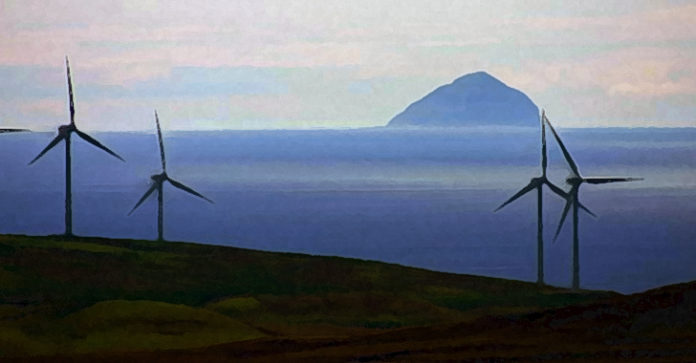
Written by Claire Bernish at theantimedia.org
Scotland managed to derive half of all its electricity from renewable energy sources last year—a full year ahead of the already ambitious goal it had set. Recently released data show that 49.8% of the country’s gross electrical consumption came from renewables—accounting for 30% of all renewable energy in the entire U.K. in 2014—and the country is on target to meet the intended 100% mark by 2020. According to the U.K. Department for Energy and Climate Change (DECC), Scotland utilized 21% more renewable-derived energy in 2014 than it had in 2013.
This rapid progress has continued in 2015 as wind-generated power in the first three months increased by 10% from sources on shore and 17% offshore over the last quarter in 2014, which was also 4.3% higher than the previous record set during the first quarter that year. This year looks promising in another respect as the “installed renewable electricity capacity”—infrastructure and other aspects necessary to derive energy from renewable sources—was up by 8.7% in the first quarter this year over the same time period in 2014.

Despite 25% growth in hydroelectric power in 2014 over 2013 figures, it accounted for less than half of what wind contributed to renewable energy goals. A 104% increase in solar power only represented a fraction of the total. In gigawatt-hours, wind contributed 11,740.6 GWh, hydro totaled 5454.5 GWh, solar 137.9 GWh, and total GWh for all renewables totaled 19,066.8 in 2014. To give you an idea of what this represents, a comparison is in order.
In the U.S., the Business Council for Sustainable Energy reports that 40% of consumption was derived from “sustainable” resources. This sounds rather promising, right? Yet what the report fails to make obvious for headline-skimmers is that truly renewable resources (solar, wind, hydro, etc.) only accounted for 13% of that total—the remaining 27% was attributed to natural gas, with a large majority of that number due to vast increases in fracking. Lumping fracked natural gas in the same category with actual, renewable energy sources creates the perception that the industry has little impact on pollution and climate change when the reality—though officially the subject of controversy—doesn’t hold this to be true.
Methane, the main component of natural gas, traps 25 times more heat in the atmosphere than carbon dioxide and escapes in rapid quantities during the fracking process. In a single county in Colorado, NOAA scientistsestimated 4% of the methane from drilling wells escaped into the atmosphere—the carbon-emitting equivalent of 1-3 million vehicles.Alarmingly, air quality around fracking wells in rural Wyoming oncereached levels two-thirds higher than what the EPA recommends—eclipsing the worst recorded numbers for the infamously smog-ridden city of Los Angeles. Montana has evenprojected a whopping 310% increase in nitrogen oxide pollution from its wells.
If strictly viewed in comparison to burning coal, the process of burning natural gas for energy has less effect on the environment—but this is just a red herring in the overall impact that completely ignores the toxic chemicals released from the drilling necessary to do so. Exposure to one of any number of chemicals released by fracking—including benzene, nitrogen oxides, carbon monoxide, and formaldehyde, to name a few—are known to cause cancer, organ damage, birth defects, and even death.
The U.S. lags behind other developed nations—even in its goals for renewable energy—as evidenced by a bill that was just introduced in May. Seven senators proposed legislation that would establish a national Renewable Electricity Standard (RES) mandating 30% of energy consumption to be derived from renewable sources. But the goal, itself, is indicative of U.S. reliance on fossil fuels and continued capitulation to that industry—the requirement wouldn’t even be in place until 2030. Even further to the point, passage of the bill remains an iffy prospect despite the exclusion of municipal utilities from the requirement.
Senator Tom Udall is one of the co-sponsors of the legislation and has been a renewable energy advocate for some time. In his home state of New Mexico, an RES standard was established by Governor Bill Richardson in 2007 requiring 20% renewable-derived energy by 2020. But this has come under fire recently by House Republicans who view the standards as government overreach and a threat to electricity prices—a nice way of saying it threatens the profit of the oil and gas industry.
Scotland’s goal to derive 100% of its energy from renewables is undoubtedly laudable—and the data from 2014 prove the tiny country is well on its way to that goal—but is it even possible for the U.S. to follow suit?
Though fossil fuel industry mouthpieces might have you believe otherwise, a recent study proves a 100% renewable energy system—derived entirely from wind, water, and solar sources—is not only economically and technically feasible, but could be in place by 2050. That’s the conclusion of the study by Mark Jacobson of Stanford and his nine colleagues, which was recently published in the journal Energy & Environmental Science. The plan creates “road maps” of necessary guidelines for each state to achieve this ambitious goal—all while maintaining grid reliability and creating more jobs than would be lost in the fossil fuel industry. This would mean wholly eliminating reliance on energy derived from oil, coal, nuclear, biofuels, and natural gas—including fracking—by 80%-85% as of 2030, and 100% in just 35 years.
But would it ever happen?
Not likely at all. In fact, the chances are about nil when considering opposition by Congress and resistance by the masses to virtually every one of the 28 suggestions for implementation of the plan. Such a shift in thinking and, well, reality, might never happen—but it can no longer be deemed impossible to achieve.
Get Your Anonymous T-Shirt / Sweatshirt / Hoodie / Tanktop, Smartphone or Tablet Cover or Mug In Our Spreadshirt Shop! Click Here




